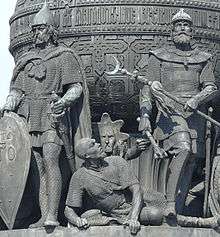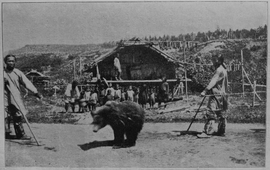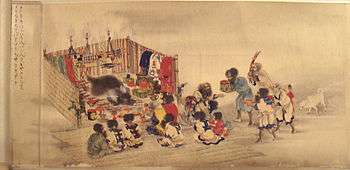Bear worship
Bear worship (also known as the bear cult or arctolatry) is the religious practice of the worshiping of bears found in many North Eurasian ethnic religions such as the Sami, Nivkh, Ainu,[1], pre-Christian Basques, and Finns.[2] There are also a number of deities from Celtic Gaul and Britain associated with the bear, and the Dacians, Thracians, and Getians were noted to worship bears and annually celebrate the bear dance festival. The bear is featured on many totems throughout northern cultures that carve them.[3]
Palaeolithic cult
The existence of an ancient bear cult among Neandertals in Western Eurasia in the Middle Paleolithic has been a topic of discussion spurred by archaeological findings.[3] The Neanderthals would have worshiped the cave bear (Ursus spelaeus) and ancient bear bones have been discovered in several different caves and are believed by some archaeologists to be evidence of a bear cult during the Paleolithic. It was not the mere presence of these bones that intrigued archaeologists, but their peculiar arrangement.[4] Upon excavation, archaeologists on site determined that the bones were found arranged in such a way that it was not naturally possible.[4] Emil Bächler, a main supporter of the argument for the presence of an ancient bear cult, found bear remains in Switzerland and at Mornova Cave in Slovenia. Along with Bächler’s discovery, bear skulls were found by André Leroi-Gourhan arranged in a perfect circle in Saône-et-Loire.[4] The discovery of designs such as those found by André Leroi-Gourhan suggests that these bear remains were placed in their arrangement intentionally; an act which has been attributed to Neandertals and is assumed to have been a part of some sort of ceremony.[4]
While some of these findings have been interpreted to indicate the presence of an ancient bear cult, certain analyses and discussions have led to contradicting results. According to Ina Wunn, based on the information archaeologists have about primitive man and bear cults, if Neandertals did, in fact, worship bears, there should be evidence of it in their settlements and camps.[5] Most bear remains have been found in caves, however, and not within early human settlements.[5] This information has implied the non-existence of an ancient bear cult and has instigated the development of new theories. Many archaeologists, including Ina Wunn, have come to believe that since most bear species reside and hide their young in caves during the winter months for hibernation, it is possible that their remains were found in the caves because caves were their natural habitat.[6] Bears lived inside these caves and perished for various reasons, whether it was illness or starvation.[7] Wunn argues that the placement of these remains, whether it appears to be an identified pattern or not, is due to natural causes such as wind, sediment, or water.[8] Therefore, in Wunn’s opinion, the assortment of bear remains in caves did not result from human activities and there is no evidence for a bear cult during the Middle Paleolithic era.[9] Certain archaeologists, such as Emil Bächler, continue to use their excavations to support that an ancient bear cult did exist.[10]
People from Russia
Eastern Slavic culture
Bear were the most worshipped animals of Ancient Slavs. During pagan times, it was associated with the god Volos, the patron of domestic animals. Slavic folklore describes the bear as a the totem personifying a male: father, husband, or a fiance. Legends about turnskin bears appeared, it was believed that humans could be turned into bears for misbehavior.[11]

Nivkh bear festival

The bear festival is a religious festival celebrated by the indigenous Nivkh in Russia's far east. A Nivkh Shaman (ch'am) would preside over the Bear Festival, celebrated in the winter between January and February depending on the clan. Bears were captured and raised in a corral for several years by local women, treating the bear like a child. The bear is considered a sacred earthly manifestation of Nivkh ancestors and the gods in bear form. During the Festival the bear is dressed in a specially made ceremonial costume and offered a banquet to take back to the realm of gods to show benevolence upon the clans.[12] After the banquet the bear is killed and eaten in an elaborate religious ceremony. The festival was arranged by relatives to honor the death of a kinsman. The bear's spirit returns to the gods of the mountain 'happy' and rewards the Nivkh with bountiful forests.[13] Generally, the Bear Festival was an inter-clan ceremony where a clan of wife-takers restored ties with a clan of wife-givers upon the broken link of the kinsman's death.[14] The Bear Festival was suppressed in the Soviet period; since then the festival has had a modest revival, albeit as a cultural rather than a religious ceremony.[15]
Ainu bear worship
The Ainu people, who live on select islands in the Japanese archipelago, call the bear “kamuy” in their language, which translates to mean "god". While many other animals are considered to be gods in the Ainu culture, the bear is the head of the gods.[16] For the Ainu, when the gods visit the world of man, they don fur and claws and take on the physical appearance of an animal. Usually, however, when the term “kamuy” is used, it essentially means a bear.[16] The Ainu people willingly and thankfully ate the bear as they believed that the disguise (the flesh and fur) of any god was a gift to the home that the god chose to visit.[17][18]
While on earth – the world of man – the Ainu believed that the gods appeared in the form of animals. The gods had the capability of taking human form, but they only took this form in their home, the country of the gods, which is outside the world of man.[16] To return a god back to his country, the people would sacrifice and eat the animal sending the god’s spirit away with civility. This ritual is called Omante and usually involves a deer or adult bear.[17]
Omante occurred when the people sacrificed an adult bear, but when they caught a bear cub they performed a different ritual which is called Iomante, in the Ainu language, or Kumamatsuri in Japanese. Kumamatsuri translates to “ bear festival” and Iomante means “sending off”.[19] The event of Kumamatsuri began with the capture of a young bear cub. As if he was a child given by the gods, the cub was fed human food from a carved wooden platter and was treated better than Ainu children for they thought of him as a god.[20] If the cub was too young and lacked the teeth to properly chew food, a nursing mother will let him suckle from her own breast.[20] When the cub reaches 2–3 years of age, the cub is taken to the altar and then sacrificed. Usually, Kumamatsuri occurs in midwinter when the bear meat is the best from the added fat.[20] The villagers will shoot it with both normal and ceremonial arrows, make offerings, dance, and pour wine on top of the cub corpse.[20] The words of sending off for the bear god are then recited. This festivity lasts for three days and three nights to properly return the bear god to his home.[20]
Bears in Korean mythology
According to legend, Ungnyeo (literally "bear woman") was a bear who turned into a woman, and gave birth to Dangun, the founder of the first Korean kingdom, Gojoseon. Along with the tiger, the bear plays an important role in Korean shamanism.
Altaic Peoples
Between 1925-1927, Dyrenkova made field observations of bear worship among the Altai, Tubalar (Tuba-Kiji), Telengit, and Shortsi of the Kuznetskaja Taiga as well as among the Sagai tribes in the regions of Minussinsk, near the Kuznetskaja Taiga (1927).
Finns
Pyrenees
There are annual bear festivals that take place in various towns and communes in the Pyrenees region.
In Prats-de-Mollo, the Fête de l'Ours ("festival of the bear") held on Candlemas (February 2) is a ritual in which men dressed up as bears brandishing sticks terrorize people in the streets.[21] Formerly, the festival centered on the "bears" mock-attacking the women and trying to blacken their breasts (with soot), which seemed scandalous to outside first-time observers. But according to the testimony of someone who remembered the olden days before that, the festival that at Prats-de-Mollo involved elaborate staging, much like the version in Arles.[22]
The Arles-sur-Tech version (Fête de l’ours d’Arles-sur-Tech) involves a female character named Rosetta (Roseta) who gets abducted by the "bear". Rosetta was traditionally played by a man or a boy dressed up as a girl. The "bear" would bring the Rosetta to a hut raised on the center square of town (where the victim would be fed sausages, cake, and white wine). The event finished with the "bear" being shaved and "killed".[23][22]
A well-known bear festival also occurs at Haute-Vallespir (Fêtes de l'ours en Vallespir).[22]
See also
- Animal worship
- Arctic
- Arcturus
- Berserker
- Kumaso
- Kumano shrine - potentially Buddhization of ancient bear worship as "kuma" means bear.
- Kalevala
- Rock carvings at Alta
References
- ↑ Bledsoe, p. 1.
- ↑ Wilfred Bonser (2012) "The Mythology of the Kalevala, with Notes on Bear-Worship Among the Finns.", p. 344
- 1 2 Wunn 2000, pp. 434-435.
- 1 2 3 4 Wunn 2000, p. 435.
- 1 2 Wunn 2000, p. 436.
- ↑ Wunn 2000, pp. 436-437.
- ↑ Wunn 2000, p. 437.
- ↑ Wunn 2000, pp. 437-438.
- ↑ Wunn 2000, pp. 438.
- ↑ Wunn 2000.
- ↑ "The Most Russian of All Beasts". Retrieved 21 September 2018.
- ↑ Chaussonnet 1995, pp. 35,81.
- ↑ Sternberg & Grant 1999, p. 160.
- ↑ Chaussonnet 1995, p. 35.
- ↑ Gall 1998, pp. 4-6.
- 1 2 3 Kindaichi & Yoshida 1949, p. 345.
- 1 2 Kindaichi & Yoshida 1949, p. 348.
- ↑ O. Harrassowitz (2007) "Journal of Asian History, Volume 41", p. 134-135
- ↑ Kindaichi & Yoshida 1949, pp. 348-349.
- 1 2 3 4 5 Kindaichi & Yoshida 1949, p. 349.
- ↑ Webb, Mick (n.d.), Bear Mountain: The battle to save the Pyrenean brown bear, Guardian Books
- 1 2 3 Fabre, Daniel (1969), "Recherches sur Jean de l'Ours (2e partie)" (PDF), Folklore: revue d'ethnographie méridonale, XXII (134): 10–11
- ↑ Crichton, Robin, ed. (2007), Monsieur Mackintosh: the travels and paintings of Charles Rennie Mackintosh in the Pyrénées Orientales, 1923-1927, Luath, p. 41
Sources
- Bledsoe, Brandon. "The Significance of the Bear Ritual Among the Sami and Other Northern Cultures". Archived from the original on 9 January 2008.
- Chaussonnet, Valerie (1995). Native Cultures of Alaska and Siberia. Washington, D.C.: Arctic Studies Center. p. 112. ISBN 1-56098-661-1.
- Gall, Timothy L. (1998). Worldmark Encyclopedia of Cultures and Daily Life. Nivkhs. Detroit, Michigan: Gale: Research Inc. p. 2100. ISBN 0-7876-0552-2.
- Kindaichi, Kyōsuke; Yoshida, Minori (Winter 1949). "The Concepts behind the Ainu Bear Festival (Kumamatsuri)". Southwestern Journal of Anthropology. University of New Mexico. 5 (4): 345–350. JSTOR 3628594.
- Sternberg, Lev Iakovlevich; Grant, Bruce (1999). The Social Organization of the Gilyak. Seattle: University of Washington Press. ISBN 0-295-97799-X.
- Wunn, Ina (2000). "Beginning of Religion" (PDF). Numen. 47 (4).
External links
- Arctolatry - A website outlining historical forms of arctolatry throughout the world with maps and timelines.
- @arctolatrystudies - A Facebook page dedicated to the study of acrtolatry.
Further reading
- Ashe, Geoffrey, Dawn Behind the Dawn, Holt 1992.
- Johnson, Buffie, Lady of the Beasts, Harper San Francisco 1988.
- Shepard, Paul and Barry Sanders, The Sacred Paw: The Bear in Nature, Myth, and Literature, Arkana 1992.
- Campbell, Joseph, Primitive Mythology (The Masks of God, #1), Penguin Arkana 1991 (first published 1959).
